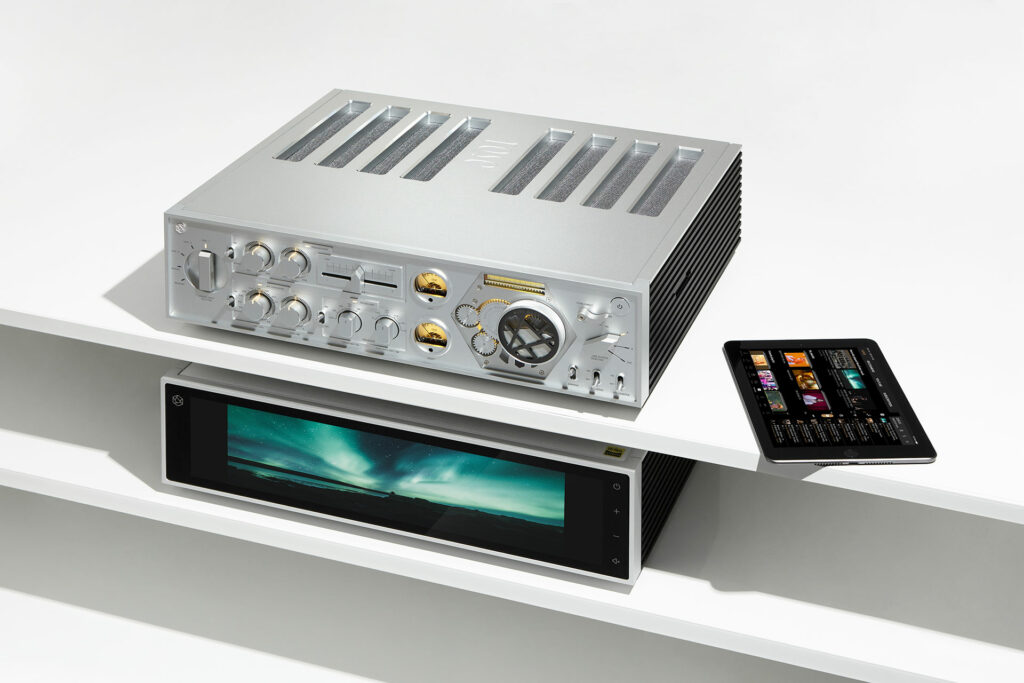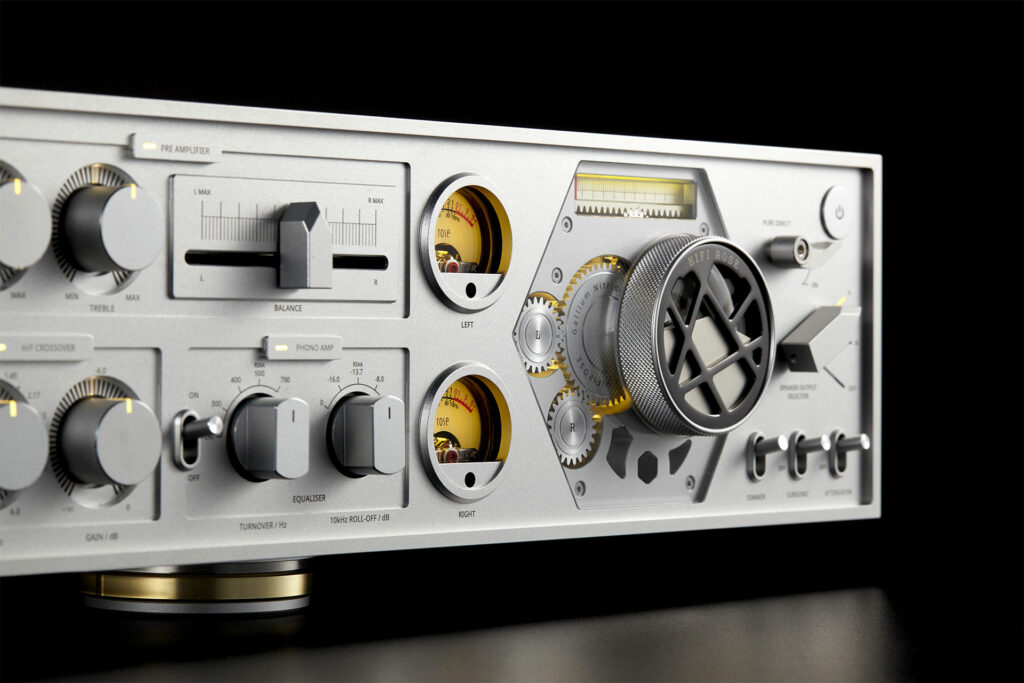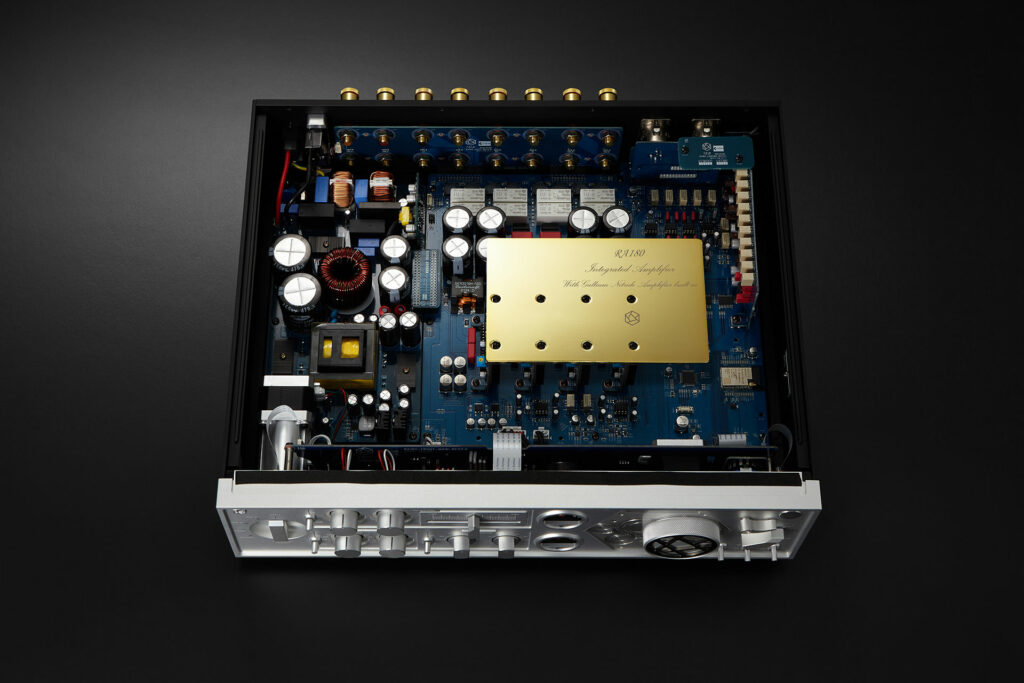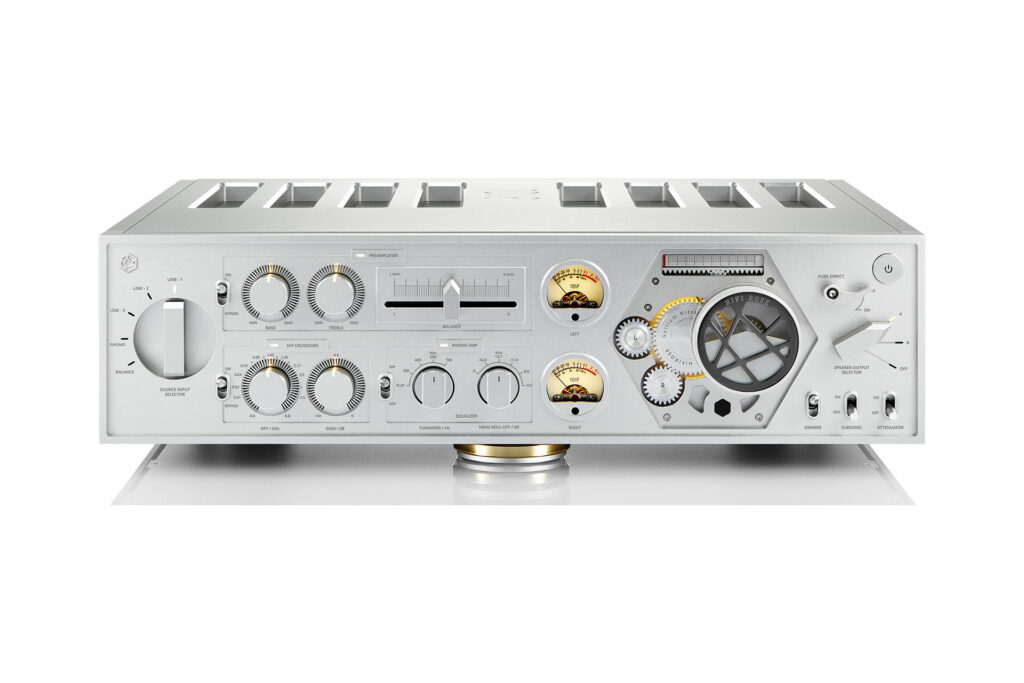Let’s face it, not every audiophile has the room or desire for separate components for their electronics. The HiFi Rose RA180 integrated amplifier (buy at Crutchfield) was built specifically for this group of audiophiles who prefer a one-box approach, but also don’t want to sacrifice sound quality at the expense of simplicity. Created in 2017, South Korean audio company HiFi Rose was the brainchild of an executive at its large parent company CiTech, who also happened to be an audiophile. With plenty of engineering and R&D resources at its disposal from CiTech, HiFi Rose quickly introduced several innovative products, including the HiFi Rose RS150B network streamer at $4,995 (buy at Crutchfield), garnering the company a reputation as a bit of an audio industry darling. More recently, HiFi Rose decided to jump into the deep end of the analog pool with the introduction of their reference-level HiFi Rose RA180 integrated amp. I emphasize analog, because there is no DAC built into the RA180 integrated amp. The RA180 integrated amp represents HiFi Rose’s attempt to push Class-D integrated amplifier technology beyond its current state. In so doing, HiFi Rose opted to use newer GaN FET (Gallium Nitride transistor) technology, instead of the more common legacy silicon FET (silicon transistor) technology, with the goal of achieving a sound quality more characteristic of a Class-A or Class-AB amp, but with the improved efficiency of a Class-D design. To differentiate their use of the new GaN FET technology, HiFi Rose refers to their RA180 integrated amp as “Class-AD,” instead of Class-D. At FutureAudiophile.com, we’ve been watching with interest as more manufacturers have begun using GaN FET topology in their Class-D amplifiers. My colleague Michael Zisserson has had experience with this technology for a some time now, having reviewed GaN-based amplifiers such as the AGD Productions Tempo di GaN amplifier and the Peachtree Audio GaN 1 amplifier.

The HiFi Rose R180 also distinguishes itself from the competition with a truly unique design aesthetic and feature set. The first thing you’ll notice is that the styling of the numerous controls on the HiFi Rose RA180’s aluminum faceplate is unlike any other on the market, while it’s immediately evident that the build quality is worthy of being called high-end. All controls feel solid to the touch and smooth-operating. But I suspect that, as with all unique designs, at first glance the overall aesthetic will be a bit polarizing. Some are going to immediately ogle it as opulent audio jewelry, while those biased toward minimalist design (like me) will find themselves wondering what HiFi Rose was thinking. The input selector and speaker selector switches remind me of high-end Swiss audio manufacturer Nagra’s gear. But then there is the retro look to the tone controls, phono controls, the two analog VU source level meters and the myriad of toggle switches. Finally, there is the industrial look of the large, knurled volume knob, with its embedded skeletal company logo in front of a hexagonal window displaying gears and a sawtooth volume level indicator, whose design seems inspired by the inner workings of a mechanical watch. Whether you’re a fan of the RA180’s design aesthetic or not, it’s hard not to agree that it stands out in a sea of lookalike integrateds. But does the new GaN FET technology make the RA180 really sound more like Class-A or Class-AB amps than traditional Class-D amps? Is the RA180 really a “reference-level” integrated amplifier? And does the HiFi Rose RA180’s feature set and sound quality justify its price? Read on, as I dive into the details a bit more for you…

What Makes the HiFi Rose RA180 Integrated Amplifier So Special?
- The RA180 integrated is a GaN (Gallium Nitride) advanced Class-D switching amplifier. GaN FETs offer several advantages over traditional silicon FETs (some people call them “digital amps”; that’s a misnomer, but you get the idea) traditionally found in Class-D switching amps, including ten times faster switching speed and at double the frequency (800 kHz for GaN FET versus 400 kHz for traditional silicon FET). Well, faster switching speed reduces switching losses and improves efficiency. Higher switching frequencies result in designs requiring fewer external components than traditional silicon designs, thereby simplifying amplifier designs. Done properly, GaN FET amp designs yield a sound that is detailed yet smooth and natural, without any of the harshness or edginess that tend to plague some silicon FET Class-D designs.
- The HiFi Rose RA180 integrated has a balanced, switched mode power supply (SMPS), designed in-house and purpose-built for the RA180, with an output capacity of 1,000 watts. The power supply is beefy, enabling the delivery of up to 200 watts each into four channels or 400 watts each into two channels. The SMPS also supports a high damping factor of at least 200. Damping factor is the amplifier’s ability to control speaker motion once a signal has stopped. Generally speaking, a higher damping factor results in tighter, more controlled bass. Bottom line, the RA180 should be capable of making even the most difficult to drive speakers reach their potential.
- While most of the GaN Class D amplifiers currently on the market tend to be smaller, lightweight designs, the HiFi Rose RA180 integrated amp has a traditional form factor, measuring 16.9 inches wide by 4.9 inches tall. While single-purpose Class-D amplifiers can easily be made smaller, the traditional form factor is a better fit for all of the hardware needed for the robust feature set of the RA180.
- Two sets of speakers can be connected to the HiFi Rose RA180. This is great for saving cost, as it enables music to be played in two different spaces from a single set of audio components. The caveat here is that only one set of loudspeakers can be played at a time.
- The HiFi Rose RA180 integrated amplifier has four amplifier modules that can individually output up to 200 watts each into four mono amplifier channels, or be bridged into two amplifier blocks to deliver up to 400 watts each into two channels. The three position BTL (Bridge Tied Load) mode selector switch on the back, along with an internal crossover, enables several connection options. Mode One allows you to use two modes to power your speakers and there are some who like this best at 200 watts per side. Mode Two is a 400 watt bi-amp configuration which, of course, has more power. Mode Three allows the first two modes to power your speakers and the next two to power super tweeters which is a rare configuration but not unheard of. BTL Mode is 400 watts which is what I liked best and what most of the people who buy the RA180 will use.
- The HiFi Rose RA180 integrated amplifier is equipped with a built-in phono stage that is compatible with both MM and MC cartridges by way of a selector switch on the back panel. There is a caveat, though. While HiFi Rose says the phono stage is compatible with MC cartridges, there is no loading adjustment available. Loading comes preset at 47k ohms, so it’s only compatible with high-output moving coils.
- Vinyl owners of vintage records will appreciate the phono equalizer controls on the front panel, which enable the user to select one of nine different equalizations used by various record manufacturers. (A chart of settings by manufacturer is provided in the owner’s manual.) Before the RIAA (Recording Industry Association of America) equalization standard was fully adopted, each manufacturer used their own custom equalization settings. Owners of vinyl from the 1940s to mid-1960s are able to duplicate those custom settings for accurate playback. There is also a subsonic switch on the front panel to cut off ultra-low frequencies, preventing speaker vibration from negatively affecting playback on nearby turntables.
- The HiFi Rose RA180 integrated has individual tone controls for bass, treble and balance to address suboptimal environments or recordings. These controls come in the form of knobs for bass and treble, as well as a slider switch for balance, reminding me of the integrated amps of the 1980s. While I am fortunate to have a properly set-up listening room, others may have suboptimal setups that can benefit from these controls.
- The HiFi Rose RA180 can be connected to your home WIFI network. With this network connection and the Rose Amp app installed on your tablet or phone, you can control the volume or source selection remotely, and also view the status of several additional amplifier settings.
- A cool feature is the ability to visibly control the geared volume dial setting or source selector switch remotely. While pressing these controls on the included remote control or the app on your phone or tablet, you can watch the geared volume dial, sawtooth volume level indicator, and the source selector all physically move.
- The bypass power amp mode switch on the front is HiFi Rose’s name for a home theater bypass that connects Line Level Input 3 directly to the power amp. This provides the ability to connect a receiver or processor, upgrading the sound quality of the two main channels by using the RA180 integrated.
- The HiFi Rose RA180 integrated amplifier excels at playing music at low volumes. My listening room is directly above my wife’s home office. While she’s working, I’m mindful to keep volume set quite low so as not to disturb her. Time after time, I was struck by the fact that, with the RA180 in my system, the soundstage didn’t collapse as much or sound as thin or flat as it did when playing other amplifiers at similarly low volume.

Why Should You Care About the HiFi Rose RA180 Integrated Amplifier?
The audio enthusiast interested in the HiFi Rose RA180 integrated amplifier is someone who’s willing to commit significant money, but not uber money, in achieving reference level. Their preference is sound that is transparent, smooth and natural, like a good Class-A or Class-AB amp, but without the excess heat. This audio enthusiast is also open-minded about exploring new, advanced technology in order to get there. Those interested also believe that keeping their DAC separate from the amplifier enables better sound during playback.

Some Things You Might Not Like About the HiFi Rose RA180 Integrated Amplifier
- The styling of the front panel of the HiFi Rose RA180 integrated amplifier is potentially polarizing. For reasons explained earlier, the styling can be a positive or a negative, depending on individual design preference. And while it doesn’t impact performance, there’s no denying that aesthetics plays more of a part in purchase decisions as price points increase.
- There’s no low-pass filter (LPF) crossover available for the single subwoofer output.The subwoofer output is a full-range mono signal. It’s disappointing that HiFi Rose didn’t give as much attention to this detail as they did to their HPF crossover for super tweeters.
- Two of the three speaker connection options are irrelevant without the use of super tweeters. Very few U.S. audiophiles use super tweeters, so these options are essentially irrelevant.
Listening to the HiFi Rose RA180 Integrated Amplifier…
For this review, I connected a dedicated Mac Mini music server to my Esoteric K-03 CD/SACD player and the Esoteric to the HiFi Rose RA180, enabling me to use the same reference-level DAC in the Esoteric, regardless of source. I connected the RA180 to Aerial Acoustics 7T tower loudspeakersusing the BTL mode setting, providing the Aerials up to 400 watts into each channel.
Piano is one of the most difficult instruments to reproduce accurately. An amp has to be fast, with enough power and headroom to portray the percussiveness and decay of the piano in a lifelike manner. Listening to Dua Lipa’s track “New Rules (Piano, Acoustic; Live)” from her Live Acoustic EP was a great example of how the HiFi Rose RA180 reproduces piano while recreating an acoustic space. This live track consists of just Lipa’s vocal, accompanied by piano. The transients of the high piano notes played early in the song are sharp, even slightly shrill-sounding, as they should be, so that is no knock on this amp, as it is true to the master recording. The length of decay of notes helped to clearly define the size and acoustics of the space. Throughout the rise and fall of the dramatic piano playing, the instrument sounded natural and alive, even when filling the space with sound. Even during these moments, the R180’s ability to precisely place the singer front and center, with the piano further back in the soundstage, ensured that the details of her vocal always came through clearly, rather than being overpowered by the piano. Sounds never seemed to be strained or artificially emphasized through the RA180 either. Instead, the amp and speakers just seemed to disappear, letting me hear the piano and vocalist as though I was in the recording space with the two performers.
My wife and I enjoy listening to live music, including everything from rock concerts to Broadway musicals. Recently, we attended MJ The Musical at Segerstrom Center. That performance inspired me to listen to Michael Jackson’s Thriller album using the RA180. Listening to the hit “Billie Jean,”the RA180 reproduced the iconic opening drum beat with great finesse and detail. The hi-hat sounded vibrant yet polished. The snare drum had good snap to the attack, with just a little decay, and the kick drum sound was short with a decent amount of high end. At the same time, I could clearly hear small details like the cabasa being played to the right of the drumkit. And the RA180 had plenty of power and headroom to accurately present the driving bass guitar beat as full, round and deep, but controlled at the same time. The track has a fairly big dynamic range, and the speed and power of the RA180 had no problem keeping up with sudden changes in dynamics. The RA180 revealed its transparent and natural qualities, while reproducing all of the nuances of Jackson’s energetic high tenor vocal, including all of his trademark tics and breathiness. I’ve heard this song countless times, but I’ve never heard all the details so naturally portrayed as I did with the HiFi Rose RA180 integrated.
Will the HiFi Rose RA180 Integrated Amplifier Hold Its Value?
At this point, the feature set of the HiFi Rose RA180 integrated amplifier is unique among its peers. I suspect most audiophiles purchasing this integrated are likely going to buy it either to pair with a very high-quality network streamer, such as the HiFi Rose RS150B, or to pair with a difficult-to-drive pair of loudspeakers, or both. Its ability to sound like a very good Class-A or Class-AB amplifier, without doing double duty as a woodstove in the process, could lead to lengthy retention. In the rare instances when an RA180 integrated amp does come on the market, I would expect it to be snatched up quickly, while selling for a healthy percentage of the retail price.

What is the Competition for the HiFi Rose RA180 Integrated Amplifier?
Again, because of the HiFi Rose RA180 is one of the first integrateds on the market, using GaN FET technology and with a unique feature set, I don’t know of a competitor with a GaN-based integrated amplifier of similar quality and price in the market yet. Yes, there is the reference Technics SU-R1000 integrated amplifier at $10,000, which employs four separate GaN FET power supplies. The significantly more expensive Technics SU-R1000 outputs 150 watts per channel into eight ohms, or 300 watts per channel into four ohms, making the HiFi Rose RA180 seem like a good value by comparison. The Technics has both analog and digital connection options. Being a purely digital integrated, though (not to be mistaken for Class-D), the SU-R1000 first converts all incoming analog signals to digital through a built-in ADC (Analog to Digital Converter), even those headed for the included phono stage. The Technics SU-R1000 clearly has a very different design philosophy than the analog HiFi Rose RA180 integrated amp.
For now, competition is more likely going to come from integrateds with more traditional Class-A, Class-AB or Class-D-based designs. For example, the fully-balanced Yamaha A-S3200 integrated amplifier at $8,000 (buy at Crutchfield) is a Class-AB amplifier design. The Yamaha A-S3200 has similarly high-quality, thick aluminum casework. Like the HiFi Rose RA180, the Yamaha is an all-analog integrated amp, with cool-looking analog level meters, tone controls, and no digital inputs (no built-in DAC). The Yamaha does have an additional set of balanced connections, two additional sets of unbalanced connections and a discrete headphone amplifier, compared to the RA180. The Yamaha’s large toroidal transformer provides 100 watts per channel into eight ohms, or 150 watts per channel into four ohms. Like the HiFi Rose RA180, the Yamaha also has a discrete phono stage that can be utilized for turntables with either an MM or MC cartridge. The Yamaha also has connections for two sets of speakers.
For those not needing a lot of power, the Pass Labs INT-25 integrated amplifier at $7,600 could be a viable alternative. It may have low gain at 25 watts per channel, but it’s 25 watts of fully Class-A power. Pass Labs also takes the purist approach, avoiding the incorporation of a phono stage, as well as streaming or DAC functionality. There are just three sets of unbalanced RCA inputs and one set of speaker connections. The Pass Labs INT-25 is basically a Pass Labs XA-25 amplifier, but with input switching and volume control capability thrown in.

Final Thoughts on the HiFi Rose RA180 Integrated Amplifier…
The HiFi Rose RA180 integrated amplifier is definitely a reference-level integrated amp, with newer GaN FET-based technology, advancing the current state of Class-D integrated amplifiers, making it one of the best you’ll find under $10,000. While a couple of its features are clearly targeted at the Asian market, there’s still plenty to interest American audiophiles. With its balanced power supply delivering up to 400 watts per channel, the RA180 provides more than enough power for even the most difficult to drive loudspeakers. The build quality screams high-end, while the sound quality could easily be mistaken for a very good Class-AB amp, or maybe even a Class-A amp, with its transparent, smooth and natural sound, but without the heat generation, and with better efficiency. It’s feature-rich, sports a unique aesthetic, and is definitely engaging. At its price point, the RA180 is a good value when compared to the competition. The HiFi Rose RA180 is an integrated that will likely remain in buyers’ systems for years to come.




Hi, I am right at this moment in the middle of a Seance.
I asked the Fortune Teller to Summon the Shade (Ghost) of Stereo Review’s Julian Hirsch.
As soon as he appeared, I asked Julian’s ghost his opinion of the HiFi Rose RA180 GaN integrated amp, and here is what he said:
“Of all the amplifiers I have ever seen, that is most definitely one of them!”
How could I argue with that?
all my best,
john marks